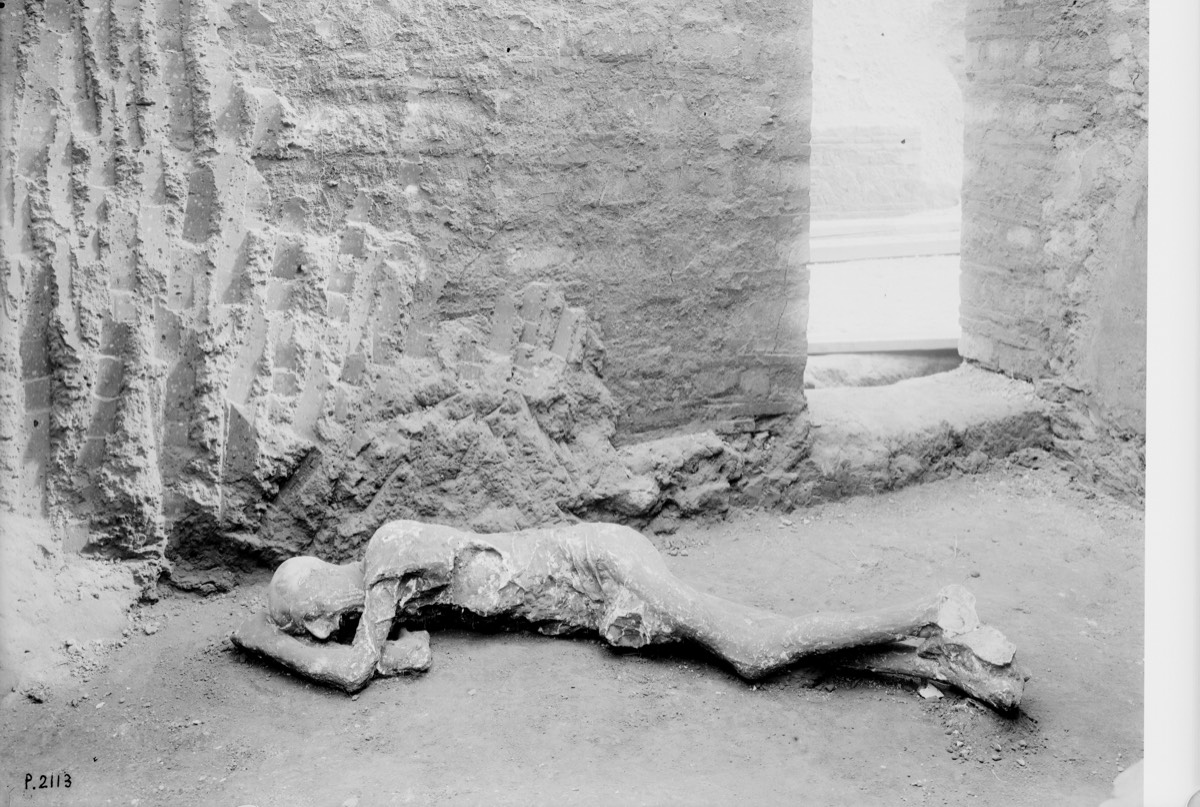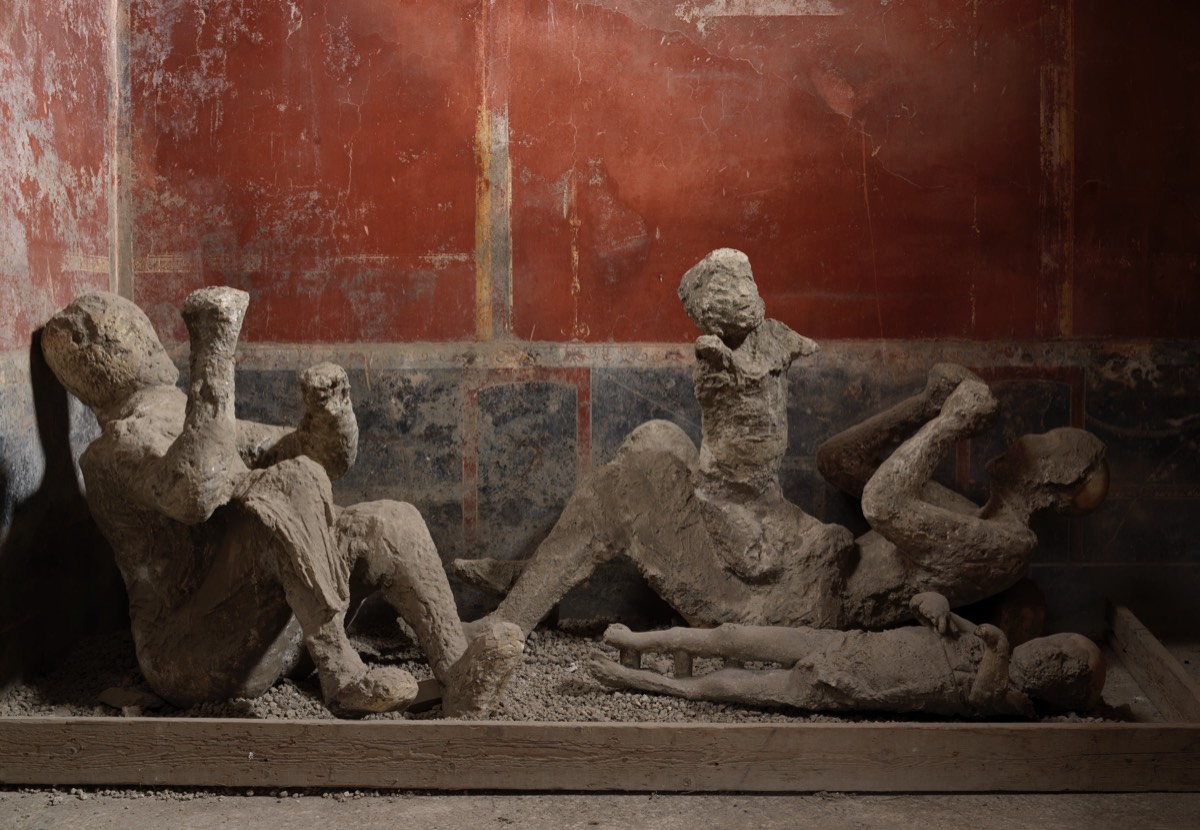Rewriting their histories
Integrating genetic data with historic and archaeological data can enrich or correct popular narratives.
DNA evidence rewrites histories of those buried in Pompeii when Vesuvius erupted.
Credit:
Archeological Park of Pompeii
People have long been fascinated by the haunting plaster casts of the bodies of people who died in Pompeii when Mount Vesuvius erupted in 79 CE. Archaeologists have presented certain popular narratives about who these people might have been and how they might have been related. But ancient DNA analysis has revealed that those preferred narratives were not entirely accurate and may reflect certain cultural biases, according to a new paper published in the journal Current Biology. The results also corroborate prior research suggesting that the people of ancient Pompeii were the descendants of immigrants from the Eastern Mediterranean.
As previously reported, the eruption of Mount Vesuvius released thermal energy roughly equivalent to 100,000 times the atomic bombs dropped on Hiroshima and Nagasaki at the end of World War II, spewing molten rock, pumice, and hot ash over the cities of Pompeii and Herculaneum in particular. The vast majority of people in Pompeii and Herculaneum—the cities hardest hit—perished from asphyxiation, choking on the thick clouds of noxious gas and ash. But at least some of the Vesuvian victims probably died instantaneously from the intense heat of fast-moving lava flows, with temperatures high enough to boil brains and explode skulls.
In the first phase, immediately after the eruption, a long column of ash and pumice blanketed the surrounding towns, most notably Pompeii and Herculaneum. By late night or early morning, pyroclastic flows (fast-moving hot ash, lava fragments, and gases) swept through and obliterated what remained, leaving the bodies of the victims frozen in seeming suspended action.
In the 19th century, an archaeologist named Giuseppe Fiorelli figured out how to make casts of those frozen bodies by pouring liquid plaster into the voids where the soft tissue had been. Some 1,000 bodies have been discovered in the ruins, and 104 plaster casts have been preserved. Restoration efforts of 86 of those casts began about 10 years ago, during which researchers took CT scans and X-rays to see if there were complete skeletons inside. Those images revealed that there had been a great deal of manipulation of the casts, depending on the aesthetics of the era in which they were made, including altering some features of the bodies’ shapes or adding metal rods to stabilize the cast, as well as frequently removing bones before casting.
Pompeii body cast in the Villa of the Mysteries.
Credit:
Pompeii body casts
The authors of this latest paper argue that these manipulations should call into question some of the popular interpretations of the identities of Pompeii victims. Drawing on multiple studies demonstrating that it is possible to retrieve DNA from both human and animal remains in Pompeii, they managed to extract genetic information from some of those plaster casts containing highly fragmented skeletal remains, in hopes of putting some of those popular interpretations to the test.
Four Pompeii victims were found in 1974 in what is known as the “House of the golden bracelet.” Three (two adults and one child) were found at the foot of a staircase leading to a garden and the seafront. Archaeologists thought this was likely a father, mother, and their child because of the arrangement of the bodies, as well as a golden bracelet worn on the arm of one of the bodies. But it wasn’t possible to definitely determine the sex of any of the bodies. The hypothesis was that the trio had taken shelter in the stairwell but were killed when it collapsed. A fourth body of a child, about age 4, was found nearby, presumed to have died while trying to escape to the garden.
This new DNA analysis showed that this conventional interpretation was incorrect. All the bodies were male, including the one with the golden bracelet, and none of them were genetically related. It wasn’t possible to glean much information about physical characteristics, but one person had black hair and dark skin, and two others probably had brown eyes. The ancestry of all four was consistent with origins in North Africa or the Mediterranean.
In 1914, nine bodies were found in the garden in front of the “House of the cryptoporticus,” so named because there is an underground passage running along three sides of that garden. Only four were preserved in plaster, including two bodies that seemed to be embracing. Archaeologists suggested they were lovers, mother/daughter, or two sisters. The authors were only able to extract DNA from one of those bodies, revealing that it was male, excluding two of those possible interpretations. His ancestry was of Near Eastern/North African origin.
Pompeii plaster casts in the House of the Golden Bracelet.
Credit:
Archeological Park of Pompeii
Several bodies were found in the “Villa of the Mysteries” in 1909–1910, known for its decorative frescoes dedicated to Bacchus, the god of wine, religious ecstasy, and fertility. The villa even had a wine press, since it was common for wealthy families to make their own wine and olive oil, among other products. The authors focused on one particular body found lying on top of a layer of ash, wearing an engraved iron and carnelian ring on the left hand. Archaeologists suggested he was probably the custodian of the villa rather than a family member.
The DNA analysis confirmed that this body was a male of mixed genetic ancestry, primarily Eastern Mediterranean and European origin. In short, “The scientific data we provide do not always align with common assumptions,” said co-author David Reich, a geneticist at Harvard University. “These findings challenge traditional gender and familial assumptions.”
Reich also cautioned against making similar mistakes with DNA analysis. “Instead of establishing new narratives that might also misrepresent these people’s experiences, the genetic results encourage reflection on the dangers of making up stories about gender and family relationships in past societies based on present-day expectations,” he said.
“Our findings have significant implications for the interpretation of archaeological data and the understanding of ancient societies,” said co-author Alissa Mittnik, also of Harvard University. “They highlight the importance of integrating genetic data with archaeological and historical information to avoid misinterpretations based on modern assumptions. This study also underscores the diverse and cosmopolitan nature of Pompeii’s population, reflecting broader patterns of mobility and cultural exchange in the Roman Empire.”
DOI: Current Biology, 2024. 10.1016/j.cub.2024.10.007 (About DOIs).
Jennifer is a senior reporter at Ars Technica with a particular focus on where science meets culture, covering everything from physics and related interdisciplinary topics to her favorite films and TV series. Jennifer lives in Baltimore with her spouse, physicist Sean M. Carroll, and their two cats, Ariel and Caliban.



















